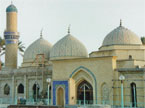More Shrines Destroyed, 60 Killed
Sistani forms Militia
KarbalaNews.net reports that [Ar.] guerrillas blew up a Shiite shrine in Bashir, south of Tuz Khurmato. This Turkmen region near Kirkuk is largely Shiite. It was not clear how much damage was done to the shrine. The people of the region formed units to guard the shrines and places of worship from any further destruction.
The same source says that [Ar.] Iraqi officers announced that 20 guerrillas attacked the shrine of Salman the Persian. They killed the guards and placed explosives at the tomb, then blew it up, destroying it.
US military sources have later denied that the shrine was destroyed, though they said it did take rocket fire. The rocket was a dud, and did no damage, they say.
Salman al-Farisi was a companion of the Prophet Muhammad who advised the early Muslims on military tactics, and is said to have introduced the technique of digging a trench to trip charging enemy cavalry. Because he was from Iran, and because the Iranians largely became Shiites after 1500, Salman is especially beloved by Shiites. The desecration took place 24 hours after 48 Shiites were killed in the same region. They had been on their way to a peaceful demonstration against Wednesday’s destruction of the Askariyah Shrine at Samarra.
Guerrillas also set off a bomb in the Shiite shrine city of Karbala, killing 8 and wounding 31.
In response to these further attacks on Islamic and Shiite shrines, Grand Ayatollah Ali Sistani called for the establishment of tribal levies to protect tsuch holy sites. He received a delegation of tribesmen from Kufa. Most of the rural clans of the Middle Euphrates are devoted to Sistani and woul be willing to provide such a militia. This proliferation of militias is however extremely worrisome.
In some of the best reporting on the role of the Shiite clerics in this crisis, Robert Worth and Ed Wong of the NYT reveal that the Americans in Iraq initially were powerless when the crisis broke out on Wednesday, and could only hope that the Shiite clerics would calm people down. They only gradually realized that the clerics were equally capable of stirring people up, and that the clerics themselves were under enormous pressure from enraged followers to do something.
This last point is why it is so dangerous for Sistani to form his tribal levies into a militia. He will be hostage in some ways to their enthusiasms.
The Iraqi army and American forces have stopped hundreds of pilgrims who had been in Karbala from heading north to Samarra.
NPR reported eyewitness accounts, corroborated by other reports, that the Mahdi Army took over several Sunni mosques in Baghdad and hung black banners from them. These banners signify the Twelfth Imam, who is associated with the tomb destroyed at Samarra. That is, the Mahdi Army took over Sunni mosques and rededicated them to the messiah of the Shiite branch of Islam, which is highly provocative.
Young Shiite nationalist Muqtada al-Sadr reached an agreement with a hard line Sunni organization to work to tamp down the communal violence.
Al-Hayat [Ar.] says that Bush called the major Iraqi politicians on Sunday to encourage them to go back to working on the government of national unity. He appears to have convinced the Sunni Arab leaders to come back to the bargaining table.




 © 2025 All Rights Reserved
© 2025 All Rights Reserved